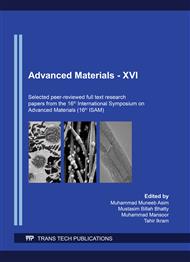[1]
K.J. Appenroth, What are heavy metals, in Plant Sciences, Acta Physiol. Plant. 32 (2010) 615–619.
DOI: 10.1007/s11738-009-0455-4
Google Scholar
[2]
J. Godt et al., The toxicity of cadmium and resulting hazards for human health, J. Occupat. Med. 6(2006) 1–6.
Google Scholar
[3]
M. Jaishankar, T. Tseten, N. Anbalagan, B.B. Mathew, K.N. Beeregowda, Toxicity, mechanism and health effects of some heavy metals, Interdiscip.Toxicol. 7(2) (2014) 60–72.
DOI: 10.2478/intox-2014-0009
Google Scholar
[4]
V. Coman, B. Robotin, P. Ilea, Nickel recovery/removal from industrial wastes - a review, Resour. Conserv.Recycl. 73 (2013) 229–238.
DOI: 10.1016/j.resconrec.2013.01.019
Google Scholar
[5]
J. Duruibe, M. Ogwuegbu, J. Egwurugwu, Heavy metal pollution and human biotoxiceffects, Int. J. Phys. Sci. 2(9) (2007) 112–118.
Google Scholar
[6]
A. Badiye, N. Kapoor, H. Khajuria, Copper Toxicity: A Comprehensive Study, Res. J. Recent Sci. 2 (2013) 58–67.
Google Scholar
[7]
R.A. Bernhoft, Mercury toxicity and treatment: A review of the literature, J. Environ. Public Health. (2012).
Google Scholar
[8]
E.M. Alissa, G.A. Ferns, Heavy metal poisoning and cardiovascular disease, J. Toxicol. (2011).
Google Scholar
[9]
T.K. Naiya, A.K. Bhattacharya, S.K. Das, Adsorption of Cd(II) and Pb(II) from aqueous solutions on activated alumina, J. Colloid. Interface Sci. 333 (2009) 14–26.
DOI: 10.1016/j.jcis.2009.01.003
Google Scholar
[10]
F. Fu, Q. Wang, Removal of heavy metal ions from wastewaters: A review, J. Environ. Manage. 92(2011) 407–418.
Google Scholar
[11]
A.F. Santos et al., Coagulation, flocculation, agglutination and hemaglutination: similar properties, (2014).
Google Scholar
[12]
V.K. Gupta, I. Ali, T.A. Saleh, A. Nayak, S. Agarwal, Chemical treatment technologies for waste-water recycling - An overview, RSC Adv. 2 (2012) 6380–6388.
DOI: 10.1039/c2ra20340e
Google Scholar
[13]
M. Amrollahi, M.T. Ghaneian, M. Tabatabaee, M.H. Ehrampoush, Highly efficient adsorbent for removal of heavy metal ions modified by a novel schiff base ligand, J. Nanostructures. 8 (2018) 374–382.
Google Scholar
[14]
Ihsanullah et al., Heavy metal removal from aqueous solution by advanced carbon nanotubes: Critical review of adsorption applications, Sep. Purif. Technol. 157 (2016) 141–161.
DOI: 10.1016/j.seppur.2015.11.039
Google Scholar
[15]
D.K. Tiwari, J. Behari, P. Sen, Application of Nanoparticles in Waste Water Treatment, 3 (2008) 417–433.
Google Scholar
[16]
M.E. Ossman, Similarity Removal of Heavy Metals from Aqueous Solutions Using Advanced Materials with Emphasis of Synthetic and Nanomaterials, 1 (2017) 131-139.
Google Scholar
[17]
J. Ahmad et al., Formation of porous α -alumina from ammonium aluminum carbonate hydroxide whiskers, Ceram. Int. 0–1 (2018).
Google Scholar
[18]
X.Q. Zhang, Y. Guo, W.C. Li, Efficient removal of hexavalent chromium by high surface area Al2O3 rods, RSC Adv. (2015) 15896–15903.
DOI: 10.1039/c4ra16953k
Google Scholar
[19]
G. Li, Y. Liu, L. Guan, X. Hu, C. Liu, Meso / macroporous g -Al2O3 fabricated by thermal decomposition of nanorods ammonium aluminium carbonate hydroxide, Mater. Res. Bull. 47(4) (2012) 1073–1079.
DOI: 10.1016/j.materresbull.2011.12.026
Google Scholar


